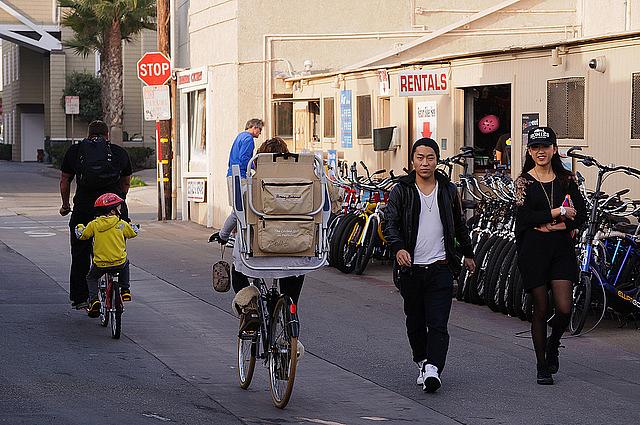How LA’s beach communities are taking cues from ‘Blue Zones’ to engineer healthy changes
Dan Buettner’s theory is that to improve public health, public spaces have to change.
Ventura Boulevard, in Los Angeles’s Woodland Hills neighborhood for instance, is loaded with cars that are often traveling to or from the nearby 101 or 405 freeways.
“You step outside, you’re going to hear this roar of motors, you’re going to smell exhaust, and no one wants to sit out there — look, no one is out there,” Buettner said during a recent interview, looking out to the street from a cafe. “But you slow traffic down, it purrs by and you take cars off the street.”
But to slow traffic down and make the roads more friendly to those who aren’t traveling by car, you have to have buy-in from the stakeholders in the area: residents, businesses, local elected officials and schools. To borrow a phrase from Buettner, you’ve got to engineer change.
That’s where the Blue Zones Project and Los Angeles County’s Beach Cities come in.
Less than 10 years have passed since the Beach Cities Health District — a former hospital district that pivoted toward preventive health — joined the Blue Zones Project, based on Buettner’s book that examined commonalities between five regions with high concentrations of centenarians.
Blue Zones Project’s purpose is to introduce longevity-focused lifestyle policy changes to willing partner communities, and in that decade, an already fitness-focused region has made substantial strides for the better.
Childhood obesity rates among elementary-aged students in Redondo Beach have dropped from about 20 percent in 2006 to 6.4 percent in 2018. A Gallup-Healthways survey of the three cities that make up the Health District — Manhattan Beach, Hermosa Beach and Redondo Beach — shows that smoking rates have dropped under 7 percent, diabetes rates are just above 5 percent and rates of high blood pressure and high cholesterol are lower than the national average.
The Beach Cities community was the first to join the Blue Zones Project, selected out of a pool of more than 70 communities and has since become a test-kitchen of sorts. The concept was initially tested on the community of Albert Lea, Minnesota, where 3,600 residents lost 2.6 pounds over a 10 month period, and health care costs of city employees fell by 49 percent. The Beach Cities were chosen because of the buy-in from local businesses and government organizations, led by the Health District.
The original program included implementing “Walking School Bus” trains of elementary school students and promoting active transit, leading cities to expand and create bicycle paths and tracks to connect cyclists from Redondo Beach up to Santa Monica. The program also looped in the business community, and affiliated grocery stores and restaurants began to focus on bringing healthful dining options to the forefront.
In the years since, the Health District has adapted the Blue Zones programs to fit community needs by focusing on mental health and wellness, and are taking steps to address substance abuse among both adults and teenagers. The Health District has also implemented plans to study the effects of its policies and practices on dementia development among the older adult population.
Beach Cities schools have also become invested in the Blue Zones Project. Gardens have been created at elementary schools across the region, and the produce has been used in those same schools’ cafeterias. The high schools have also changed policies to establish healthful food choices, including restrictions on soda.
The three municipalities have passed legislation to ban smoking in public places, which has coincided with a drop in smoking use in the region; taken part in designing a “living streets” manual; and in Redondo’s case, partnered in a worksite wellness program to encourage activity and healthy habits among its workforce.
The Beach Cities have been so successful that other communities come to the district when they’re signing on to establish the Blue Zones Project in their own community.
So with all that in mind, I’m looking to understand how this program has evolved over time. The heart of my 2019 California Fellowship project is understanding how and why communities join this program, and who is leading the charge to effectively reengineer their lives. If one part of the ring falls apart — if cities don’t pass legislation, if health leaders don’t build a curriculum, if the business community doesn’t buy in — can the project work?
Second, I want to ask whether true change is possible only in wealthy communities, where well-monied residents can swallow the higher costs of more healthful food options.
This project is going to focus on Beach Cities Health District as a starting point, but I’m also interested in looking at nascent Blue Zones Project communities throughout California, and established communities that have stark economic and demographic differences from the successful beach communities.
I’m already moving — Buettner and I met recently, and that interview led me toward a number of other branches to explore.


